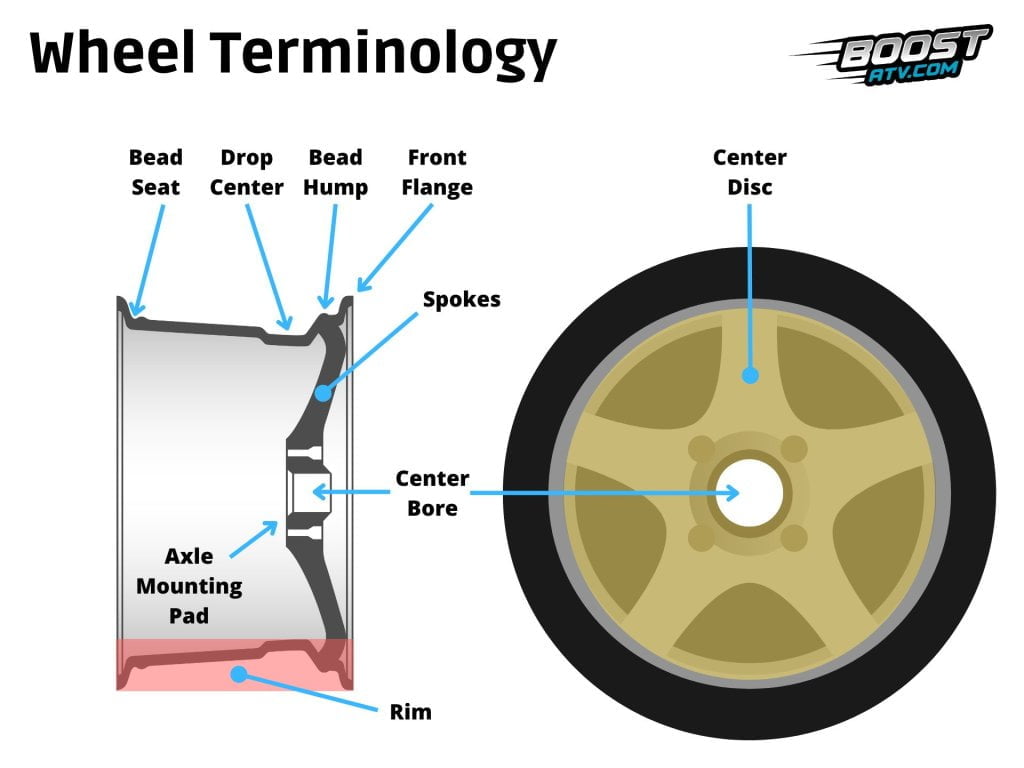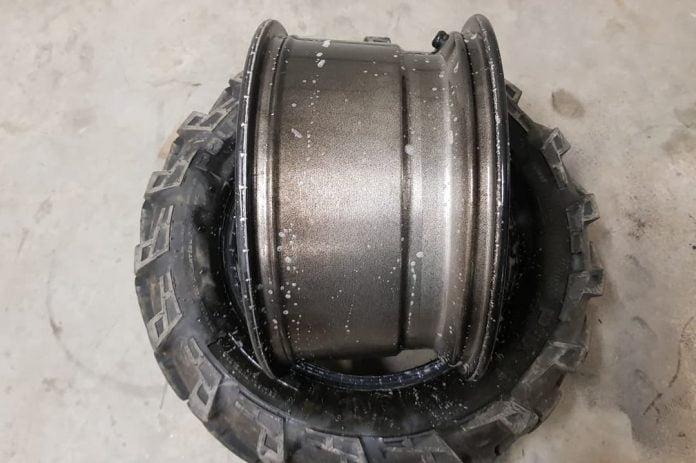Whether out of curiosity or necessity, you may wonder if ATV tires have tubes in them. It’s a legit question; I remember asking the same question when I bought my first ATV.
So are ATV tires tubeless? Most ATV tires are tubeless due to increased puncture resistance, easier repairs, and to avoid the downsides of running tubes in a low-pressure tire. You can install tubes in an ATV tire, but it is not the best alternative for most.
Why Are ATV Tires Tubeless? (Pros and Cons)
Most, if not all, new ATV tires are sold without tubes. But why do the manufacturers choose this setup instead of using inner tubes?
Let’s look at the pros and cons of tubes vs. tubeless ATV tires and why tubeless is the preferred alternative.
Tubeless Tires Are Usually Easier to Repair
ATV tires are prone to getting leaks, and they rarely happen when ATVs sit in the garage; they occur on the trail or in the woods.
You’re likely miles from the nearest tire shop, so you will need a way to repair the leak in-field.
Tubeless tires are considered easier to repair in some respects compared to traditional tube tires, but this largely depends on the nature of the damage.
For small punctures, tubeless tires can often be repaired without even removing the wheel from the vehicle. The repair process involves plugging the hole from the outside, which can be straightforward with a tubeless tire repair kit.
String plugs are generally not recommended for long-term repairs but are great for emergency repairs for ATVs out on the trail.
String plugs are generally not recommended for long-term repairs but are great for emergency repairs for ATVs out on the trail.
Tubed tires, on the other hand, cannot be patched easily out on the trail. The tire has to come off the rim for you to access and patch the damaged tube.
Damage to the sidewall of a tubeless tire can often be irreparable. This is also true for tube tires, but the risk is greater with tubeless models because they lack an inner tube that could potentially limit the damage.
Tubed Tires Can Spin on the Wheel, Breaking the Valve Stem
ATV tires run on low tire pressure for optimal off-road performance. For optimal traction and flotation on soft surfaces such as mud, snow, or sand, you may go as low as 2.5 psi to 3 psi.
However, do not go any lower as this will increase the risk of popping the tire of the bead. When running low pressure in a tire, the tire is not being pushed as hard against the rim’s inside, causing less friction.
This makes it more likely that the tire will spin on the wheel during hard acceleration or hard braking. When this happens, the tube wants to spin along with the tire. The valve stem, however, is fixed to the wheel.
This usually causes valve stem breakage and instant deflation. Plastic valve stems are more likely to break than ones made from metal.
Long Valve Stems on Tubed Tires Are More Prone to Breaking
The steel valve stems on tubes are generally longer than on a tubeless tire. Partly so that they will work with multiple applications.
This leaves them vulnerable to breakage when riding in mud or hitting ruts.
Farm tractors and forestry equipment, such as skidders, often use inner tubes. They often use an impact-resistant valve stem protector made from steel to solve the valve stem breakage issue on these machines.
Tubeless Tires Fail More Safely
Tubeless tires generally fail more safely than tube tires. A puncture in a tubeless tire usually results in a slow leak rather than a sudden blowout.
A blowout is a rapid loss of inflation pressure in a tire, which can cause sudden and uncontrollable deflation. This is a dangerous situation, especially when driving at high speeds, as it can lead to losing control of the vehicle.
Blowouts are more likely with tube tires because the tube and tire are two separate components. If the tire gets punctured, the tube inside is likely also to get punctured. Once the tube is punctured, it quickly loses air – hence, a sudden blowout.
In contrast, tubeless tires are constructed as a single unit. When a puncture happens, the air tends to escape more slowly because it is directly exposed to the hole. The tire and rim form a seal that helps prevent immediate, rapid air loss.
As a result, the driver has more time to respond to the tire pressure drop, which typically leads to a safer, more controlled situation.
A Set of New Tires Do Not Cost That Much More Than a Set of Tubes
Moderately sized all-terrain ATV tires are relatively cheap. If you’re trying to fix a leaking stock tire, you’re likely better off getting a set of new, similar-sized tires instead of tubes.
The overall result will be much better. As a bonus, you get fresh new rubber and grippy threads, all for just a few dollars more than a set of tubes.
You can get a decent ATV tire for around $40 to $50. Tubes are typically $20 to $30. New tires will cost you a bit more than tubes, but the result is many times better.
In this post, we compare the price of different types and sizes of ATV tires.
Can You Put Tubes in ATV Tires?
Some leaks are harder to find and repair. A common issue with tubeless tires is that it keeps leaking in the bead area. In such situations, you might feel like giving up and just getting inner tubes instead.
You can certainly choose to put tubes in your tubeless ATV tire. While this might work for some people, usually, there are more effective solutions.
But is it ok to install tubes to fix a leaking ATV tire?
Yes, you can install tubes in ATV tires if you understand and accept the downsides, such as the risk of valve stem breakage and having to ride at a higher tire pressure.
But for most ATV riding applications, it is generally not an alternative we recommend. For fixing flats and leaks, there are much better alternatives.
This post looks more in-depth at different methods for fixing a leaking ATV tire.
To transition from a tubeless tire to installing a tube, you might need to make some modifications, such as putting silicone around the valve stem.
The valve stems on tubeless tires often has a bigger diameter than on tubes. If you leave this gap, exposed sand and debris will soon find their way to the inside of the tire, causing leaks.
When considering tubes as an alternative to fixing a tire leak, don’t forget to patch the hole in the tire regardless. Otherwise, you risk dirt getting inside the tire through the tear or hole.
How Do Tubeless ATV Tires Stay Inflated?
A tubeless ATV stays inflated because the pressure inside the tire pushes the tire sidewalls out against the wheel’s bead, creating an airtight seal.
ATV tires often use low tire pressure for better off-road traction. If tire pressure is too low, the seal may weaken, and the air starts seeping out of the tire.
If you have ever watched a tire being installed to a rim, you may have heard the distinct popping sound when the tire seats to the rim.
On the inside of the rim, there is a little ridge near the edge of the tire, also known as the bead. This ridge extends around the entire rim, with one on each side.

When inflating the tire, it will pop over this bump before it rests against the inside of the bead flange.

Many believe this bump keeps the tire inflated, but that is only half true. The bumps’ primary purpose is to prevent the tire from sliding sideways when cornering at high speeds or riding across slopes.
This prevents the tire from deflating suddenly from a sharp turn or sideways impact. But for the tire to seal completely, you need a certain level of air pressure inside the tire.
FAQ
What are the advantages of tubeless ATV tires?
Tubeless ATV tires offer better heat dissipation, reduced risk of blowouts, and allow for emergency run-flat situations, enhancing safety.
Is it necessary to balance ATV tires when switching from tube to tubeless?
While not always necessary, balancing ATV tires when switching can improve ride smoothness and tire longevity.
Can I convert my tubed ATV tires to tubeless?
Yes, it’s possible to convert tubed ATV tires to tubeless with the right equipment and process, but professional installation is often recommended for safety.
The Bottom Line
To conclude, tubeless tires are the standard choice for ATVs due to their ease of repair, better performance under low pressure, and less risk of valve stem breakage.
While tubed tires may seem like a tempting alternative for certain situations, their use often comes with many complications, making them less ideal.
